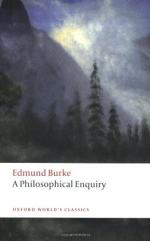
|
Sepia-toned Splendor
One of the favorite activities of 18th century upper-class English society was to view the countryside through a "Claude Glass," named after the 17th century landscape painter Claude Lorrain. This is a slightly convex and blackened mirror designed to give the reflection of a natural landscape more rough and sublime. Create your own Claude Glass by using clear or sepia-toned plastic sheeting and speckled the edges with black paint or ink. Looking through this window, how is the landscape changed? Have any specific elements of the view transitioned from the beautiful to the sublime?
Poetic Interpretation
Individually or with a partner, write a poem about an object you think would qualify, according to Burke, as either beautiful or sublime. Focus on the qualities of the beautiful or sublime as Burke identifies them, and apply these definitions to the object. Try to use Burke's terminology, where appropriate...
|
This section contains 2,251 words (approx. 8 pages at 300 words per page) |

|




